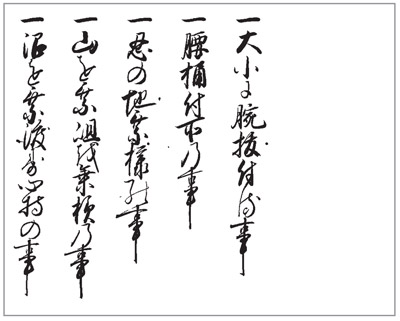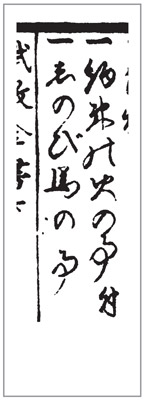In Search of the Niinja (24 page)
Read In Search of the Niinja Online
Authors: Antony Cummins

Baiboku
 or Mouth Gags
or Mouth GagsThe
Shoninki
ninja manual lists ten ancient ways of ninjutsu that are described as fundamental building blocks of the shinobi arts. The first principle of the ten is named as
Onsei
-
nin
and concerns sound. The word
Baiboku
emerges with regard to information gathering, music and eavesdropping.
Baiboku
was initially thought to be the concept of gagging a horse, but it was in fact also the skill of gagging humans of their own free will. Those who engaged in
Youchi
or night raids, including shinobi, would place wooden sticks in their mouths and tie them around their heads for security with the aim of the individual and the team remaining silent during their raid. Perhaps only the samurai troops were gagged and the shinobi kept their mouths free to use passwords and to talk to each other.
The ideogram for
Baiboku
is made up of – which consists of ‘holding a rod’ and the ideogram
– which consists of ‘holding a rod’ and the ideogram wood, thus ‘wooden gag’. It is unknown whether the
wood, thus ‘wooden gag’. It is unknown whether the
Baiboku
gag was flat or round, however it was logically a fraction wider than the mouth and has been described in modern dictionaries as having the thickness of a chopstick.
The appearance of the
Baiboku
gag in the
Shoninki
manual, though brief, shows how Natori hid his teachings. He does not describe its use, nor its construction, which fortunately can be inferred from other manuals.
The
Baiboku
can be found outside of the shinobi arts and in Chinese literature. According to Sawyer the
T
’
ai-pai Yin-ching
Chinese war manual contains a form of
Baiboku
used by ‘Incendiary Troops’ during cavalry excursions. It also states that the horses should be gagged or bound, showing a relationship to the Japanese
Otsubohon-Ryu
school of horsemanship, discussed later.
Baiboku
gags are found in T’ai Kung’s Six Secret Teachings
.
The Tiger Secret Teachings scroll talks of raids – ‘Require the soldiers to put wooden gags into their mouths, then move out at night.’ According to various Japanese manuals, it was also a practice to gag a horse’s mouth in a more restrictive way than a normal bit, to ensure the silence of the animal. The gags are known in Japanese as ‘shinobi horse bits’ and again, this appears in Chinese literature.
into their mouths, then move out at night.’ According to various Japanese manuals, it was also a practice to gag a horse’s mouth in a more restrictive way than a normal bit, to ensure the silence of the animal. The gags are known in Japanese as ‘shinobi horse bits’ and again, this appears in Chinese literature.

The author wearing the
Baiboku
gag used to keep men quiet on a night raid.
To follow on with this equestrian theme, the translation in the next skill set comes from an undated manual of the
Otsubo hon
school of horsemanship and displays how the shinobi used gagged horses as described in both Chinese war texts and Japanese manuals.
The horse and the ninja appear to be an unlikely combination, as horsemanship in connection to Japanese scouting appears to be linked predominantly to
Monomi
scouts. However the
Otsubo Hon-ryu
, a prestigious school of horsemanship, has an account taken from oral traditions concerning the ninja and horses.
Preparing a horse for a
shinobi
mission from the
Otsubo Hon
school of horsemanship:
When you ride at night you should cover the eyes of your horse fully and avoid using horse shoes.
68
However if it’s a horse that makes a loud stepping sound you should cover the hooves or use fur shoes. In the case that you do not have any fur, you should use normal shoes and make improvements by saturating them in water before you put them on. The details for this are secret. When applying the horse bit you need to apply wet paper [to the bit] and you should tie the tongue up with thin string before you ride out. This is called ‘The Way of the Dragon’s Whisper’. The string used for tying the tongue should be soaked in sparrow’s blood and meat and then dried. If the horse is easily frightened by small sounds use the method called Shi’in or the paper cover, this is the idea of putting paper in the horse’s ears, the details are secret.

The
Tazuna no mokuroku
scroll of 1694 showing a list of horse skills to be learned by a student of the school. The central one lists ninja horse skills.
The rider should close his eyes when he leaves the camp [to maintain his night vision]. After a whilst open your eyes and observe the way you are going so you can see the way ahead ‘clearly’ even in pitch darkness. This also, is secret. This is how a shinobi rides a horse.
When a shinobi rides a horse he should cover the horse’s eyes because if he comes from an illuminated place into a dark one, he will be blinded. Therefore you should also cover the horse’s eyes where there are lights. In this way you make it dark even where it is light. Keep the horse’s eyes covered until you are outside of the bright area and keep him running for two or three
Cho
and then open his eyes, so that they can see the road clearly.

Yamaga-ryu
also lists ninja horsemanship in its school.
The reason you should not put shoes on the horse is that, if you are attacked by the enemy, you have to return as quickly as possible, and if you put shoes on the horse, it will not run well, therefore do not put shoes on horses. However, it is difficult not to put them on a horse whose step is loud. If the stepping is loud, the enemy will realise you are coming in advance, so, you need to be silent. Therefore, fur shoes will create a silent step. To make fur shoes you discard the sole of the normal shoes and exchange them for fur. Also you should put wet paper into the centre indents of a horse’s hooves, creating a soft tread. This is the most important way of the shinobi-horse, that is, the art of paper-shoes. Some Tozoku thieves of Joshu province happened to know this skill and when they stole horses they put fur shoes on them and took them away. If you do not have fur shoes as stated, then you need to soak normal shoes in water and use them. Again this is secret. If you put wet paper onto the back of the hooves as stated above it will fill the gap in the back of the hoof and thus make less noise. Also, you should cover the joints of the horse’s bit with wet paper and also apply this wet paper to the rings of horse tackle; this is done by rolling wet paper around them. In this way, the bit [and tackle] will not make any noise. This way was also written down in the Tales of the Heike and shinobi also use this way. So, if you tie the horse’s tongue with string it will not neigh; remember the string should be soaked in sparrow’s blood and meat. This is because sparrows are the ‘fire in the south’ and Suzaku controls your energy.
69
This is also called
Shinobi no ito
or the ‘string of the shinobi’. Remember if you use this great skill of the dragon and tie up the tongue of your horse, then it will not even make a whisper.
The
Otsubo Hon
school of horsemanship makes further reference to ninja
-
like activities, as a horse scout searching for enemies and clearing certain areas ready for an army, establishing a safe passage. As seen in the image overleaf the manual refers to a specific route taken when searching for enemy
Kamari
, a word that is known to represent ambush troops and shinobi-like hiding.
